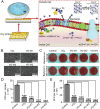Flourishing Antibacterial Strategies for Osteomyelitis Therapy
- PMID: 36717275
- PMCID: PMC10104653
- DOI: 10.1002/advs.202206154
Flourishing Antibacterial Strategies for Osteomyelitis Therapy
Abstract
Osteomyelitis is a destructive disease of bone tissue caused by infection with pathogenic microorganisms. Because of the complex and long-term abnormal conditions, osteomyelitis is one of the refractory diseases in orthopedics. Currently, anti-infective therapy is the primary modality for osteomyelitis therapy in addition to thorough surgical debridement. However, bacterial resistance has gradually reduced the benefits of traditional antibiotics, and the development of advanced antibacterial agents has received growing attention. This review introduces the main targets of antibacterial agents for treating osteomyelitis, including bacterial cell wall, cell membrane, intracellular macromolecules, and bacterial energy metabolism, focuses on their mechanisms, and predicts prospects for clinical applications.
Keywords: antibacterial agent; antibacterial mechanism; biomaterial; osteomyelitis therapy; targeted antibacterial strategy.
© 2023 The Authors. Advanced Science published by Wiley-VCH GmbH.
Conflict of interest statement
The authors declare no conflict of interest.
Figures







References
-
- a) Lew D. P., Waldvogel F. A., Lancet 2004, 364, 369; - PubMed
- b) Zeller J. L., Burke A. E., Glass R. M., J. Am. Med. Assoc. 2008, 299, 858.
Publication types
MeSH terms
Substances
Grants and funding
- 52273158/National Natural Science Foundation of China
- U21A2099/National Natural Science Foundation of China
- 52022095/National Natural Science Foundation of China
- 51973216/National Natural Science Foundation of China
- 51873207/National Natural Science Foundation of China
- 51803006/National Natural Science Foundation of China
- 82102545/National Natural Science Foundation of China
- 20210509005RQ/Science and Technology Development Program of Jilin Province
- 20210504001GH/Science and Technology Development Program of Jilin Province
- 20200404182YY/Science and Technology Development Program of Jilin Province
- 2018SCZ018/Provincial Health Specific Project of Jilin Province
- SCZSY201710/Provincial Health Specific Project of Jilin Province
- 2019SCZ025/Specific Project for Health Research Talents of Jilin Province
- 2019230/Youth Innovation Promotion Association of Chinese Academy of Sciences
- 21QC10/Youth Science and Technology Talent Innovation Project of Changchun
LinkOut - more resources
Full Text Sources
Medical
Molecular Biology Databases
